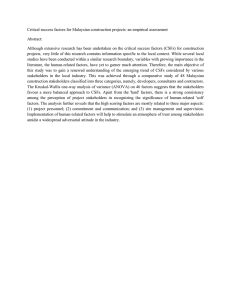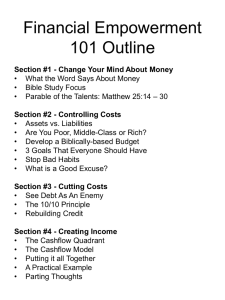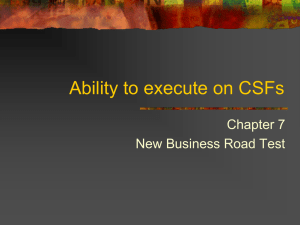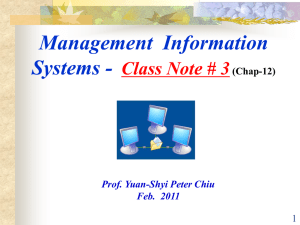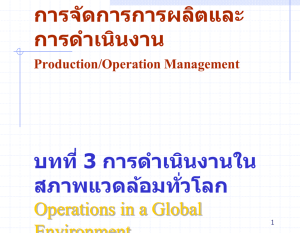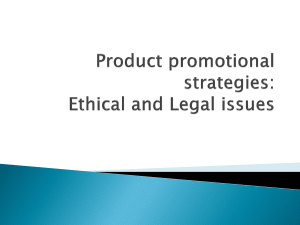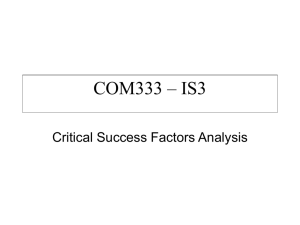Introduction to strategic management accounting
advertisement
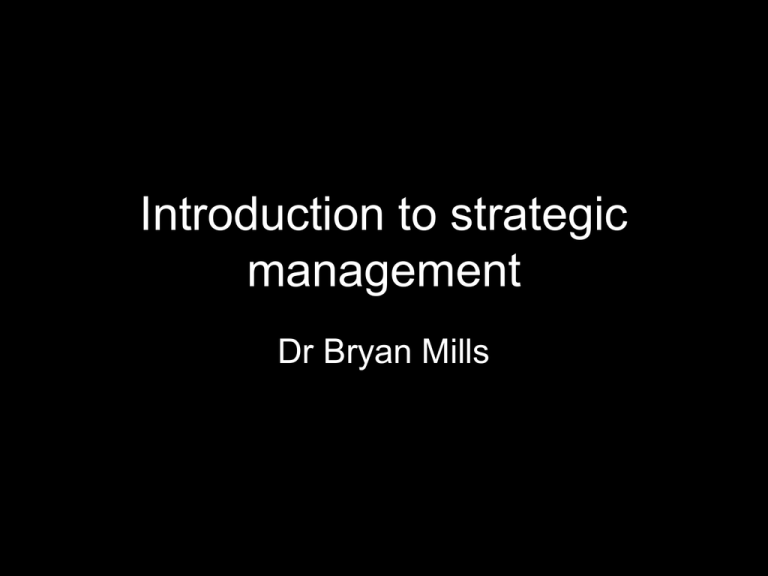
Introduction to strategic management Dr Bryan Mills Topics • • • • • • • • Definitions Information Mission/vision/objectives Gap analysis KPI Multinationals PLC Benchmarking Definitions • Strategic Planning – Overall policies and objectives • Management Control – Effective and efficient use of resources • Operational Control – Specific tasks are effective and efficient Definitions • • • • Planning……………………….. Decision making………………… Strategic decisions……………….. Control…………………. Information • Future Uncertainty – Forecasts and Estimates – Use of sensitivity analysis – DCF • Project evaluation • Managing cash and operations • Post implementation review The issues: • What makes estimating hard? – Financial Reporting – Treatment of overheads – Neat rather than useful – Internal focus – Infelxible – Historic costs – Strategic issues – Complex models Mission (values) Vision (direction) Goals (stakeholders) Objectives Corporate appraisal Gap analysis Mission versus Vision • Vision – Where is the business going (to)? • Mission – What is the business for? Vision • What the business is now • What it could be in an ideal world • What the ideal world would be like • Our vision: to become the world's leading company for automotive products and services. • Our mission: we are a global, diverse family with a proud heritage, passionately committed to providing outstanding products and services. • Our values: We do the right thing for our people, our environment and our society, but above all for our customers. Guess who 1. to organize the world’s information and make it universally accessible and useful. 2. and: 1. 2. 3. 4. 5. Leading in our chosen markets Delivering an outstanding client experience based on excellence in sales, service and solutions Achieving a superior, ethically based, long-term return for our shareholders Building highly motivated, high-performance teams Creating a challenging, rewarding and fun work environment Mission Elements of mission Detail Purpose Why – for shareholders and satisfy stakeholders Strategy Nature of business; products/services; competitive position; competence; competitive advantage Policies and standards of behaviour Mission converted to practice Value and Culture Basic (unstated?) beliefs Mission • Brief, flexible, distinctive and open-ended • Identity of whom the organisation exist to benefit • Nature of the firms business • Ways of competing (price, etc.) • Principles of business • Commitment to customers Mission and Planning • Inspires planning • Screens new plans • Affects the implementation Goals and Objectives • Goals – long term • Objectives – short-term to achieve goals • Goals expressed as SMART objectives – Specific – Measurable – Attainable – Result-oriented – Time-bound Goal Congruence • Across departments – horizontal • At all levels – vertical • Over time Goal types Goal Comment Ideological Goals Organisation’s mission Formal Goals Imposed by individuals/groups Shared Personal Goals Individuals reach consensus System Goals Independent of mission – derive from organisations existence as an organisation Goal Setting • • • • • Top-down Bottom-up By precedent- historic By diktat By consensus Goal Setting • Political process involving bargaining – Shareholder – profits – Employees – salaries – Managers – power – Customers – quality • Conflict between these objectives? Corporate Objectives • Corporate – whole – Profit; market share; growth; cashflow; ROCE; risk; Customer satisfaction; quality; Industrial relations; Added value; EPS • Unit – individual unit – Commercial – increase number of customers (sales dept.) – Public sector – more nursery places (LEA) – General – resources; market; staff development; innovation; productivity; technology Primary and Secondary Obj. • ‘opportunity cost’ of objectives • Limit to the number of objectives a manger can pursue • Should be one primary core objective • And other secondary objective – Primary – growth in profits – Secondary – sales growth; innovation; quality; resource management Secondary • Financial • Technology – Product design and development – R&D – Quality • Product market – – – – Market leader Coverage (range) Position Expansion Ranking objectives and tradeoffs • Never enough time • Degrees of achievement – 15% sales growth; 10% profit growth, £2m negative cashflow; reduced quality – 8% sales growth; 5% profit growth, £0.5m positive cashflow; quality Department plans and objectives • Document the responsibility • Prepare responsibility charts – Manager’s main objective – Programme for achieving that – Sub-objectives – Critical assumptions • Prepare activity schedules Hierarchy of objectives Mission Goals Objectives (KPIs) Strategy (Targets) Tactics Operational Plans Social Audit • Recognise rationale for engaging • Identify programme which are congruent with mission • Determine objectives and priorities • Specify nature and range of resources required • Evaluate company involvement in programmes past, present and future Ethics and ethical conduct • Social responsibilities – general stance • Ethics – how we (organisations) conduct ourselves • Amoral – ACCA – condone any action that help aim. Definition – right or wrong not valid • Legalistic – letter of law only • Responsive – see gain in ethics • Emerging ethical (ethically engaged) – active • Ethical organisations – total ethical profile Impact of corporate code • • • • • Commitment by senior management Discourage previous behaviour Staff need to be onboard Tension between code and performance Statement of ethical conduct and specific codes of practice Gap Analysis • Gap analysis –compare ultimate objective with expected performance – Determine targets – Establish what would happen if we did nothing • Planning gap – Between forecast position from carrying on as is (NOT where we are now) and forecast desired Gap Analysis M Share Want Carry on as is Time Gap and ANSOFF Target Profit/ market share Market pen. Product dev. Improve existing Forecast min http://seekingalpha.com/article/128370-tesco-a-look-at-britain-s-top-retailer Strategic choice • Strategic Options Generation – Creative • Strategic Options Evaluation – – – – Acceptable Sustainable Feasible Environmentally fit • Strategic Selection – Competitive strategy • How to – Market strategy • Where to – Institutional strategy • Method (relationship with other organisations) Assessment Assess the internal environment, Strengths and Weaknesses Assess external environment, Opportunities and Threats, Political, Economic, Social and Technological Mission Develop mission statement, or if one already exists establish how it relates to the above assessment Objectives Develop objectives using mission and assessment Evaluate Create Corporate Plan Consider alternative ways of achieving these objectives Develop a corporate plan featuring the above objectives and mission. What do you think are the differences between Strategic and Operational? Discuss • • • • Unrealistic plans Inconsistent goals Poor communication Inadequate performance measurement Not everything that counts can be counted, and not everything that can be counted counts • False alarms – Disproportionate focus on direct costs – Efficiency v effectiveness – Machine standard hour irrelevant as long as capacity exists • Gaps missed – New products – Customer satisfaction – Employee involvment Strategic control linkages Time-lag Influencers Source of comp. adv. risks Critical Success Factors • Money: positive cash flow, revenue growth, and profit margins. • Your future: Acquiring new customers and/or distributors. • Customer satisfaction: How happy are they? • Quality: How good is your product and service? • Product or service development: What's new that will increase business with existing customers and attract new ones? • Intellectual capital: Increasing what you know that's profitable. • Strategic relationships: New sources of business, products and outside revenue. • Employee attraction and retention: Your ability to do extend your reach. • Sustainability: Your personal ability to keep it all going. • Four basic types of CSFs according to Rockart: – Industry CSFs resulting from specific industry characteristics; – Strategy CSFs resulting from the chosen competitive strategy of the business; – Environmental CSFs resulting from economic or technological changes; and – Temporal CSFs resulting from internal organizational needs and changes. • http://www.e-competitors.com/Strategy/SBUPlanning/SBUPositioning/SBU_Critical.htm Strategic Performance Measures • Desirable Features – Focus on long run – Identify and communicate drivers of success – Support organisational learning – Basis for reward • Characteristics – Measurable; Meaningful; Defined by Srtat.; Consistent; Re-evaluated Regularly; Acceptable http://utdallas.edu/~vxc054000/ba3365/img/fig6.jpg But PLC Intro. Growth Financial CSF High risk Time to Launch High risk Medium Market Retention share/comp . Adv Low Timely exit Info Research Market share Costs Exit Control Milestones DCF ROI Free cash flow Cash User User Generator Generator Not Imp. Vital Important New Uses Important Negative Ret on Cap Not Imp. Growth Vital Maturity Decline Multinationals • Central headquarters in one country and subsidiaries on others – Extend PLCycle – Less competition – High growth – Reduce risk Competitive Strategy (multinational) • Cost Leadership – economies of scale • Differentiation – new product for overseas • Focus – core segment of customers • Pre-empt competition from overseas Can you think of some other reasons/problems? Control and Structure Global Opportunities High Global Product structure Global hierarchy Global Matrix Low International Division (single division) Global geographic structure (multiple) Low Multidomestic Opportunities High Protectionism • Tariffs – tax on import. %of value (ad valorem) or per unit (specific) • Quota – limit on quantity • Minimum local content rules • Minimum prices – anti-dumping • Embargos • Subsidies for domestic • Bureaucracy • Exchange Controls and Policy Benchmarking • • • • Internal Functional – regardless of industry Competitive- direct competition Strategic – action and change Stages of Benchmarking 1. 2. 3. 4. 5. 6. 7. Set objectives KPI Select organisations Measure Comapre Design improvements Monitor Risk and Uncertainty Physical Economic Business PLC Political Financial Where next? GE McKinsey Matrix http://www.emeraldinsight.com/content_images/fig/3300080110004.png http://www.softducks.com/image/icon/B/BCG-Growth-Share-Matrix-Software-90495.gif http://theexecutiveperspective.com/2010/06/01/igor-ansoffs-strategy-development-process/ http://www.vectorstudy.com/management_theories/img/porters_competitive_strategies.gif

